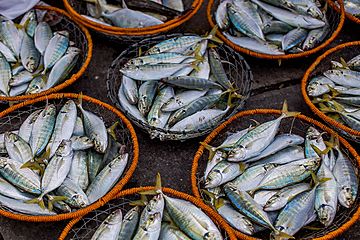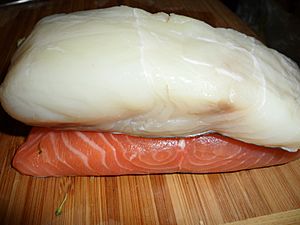Fish as food facts for kids
Many species of fish are caught by humans and consumed as food in virtually all regions around the world. Fish has been an important dietary source of protein and other nutrients throughout human history.
The English language does not have a special culinary name for food prepared from fish like with other animals (as with pig vs. pork), or as in other languages (such as Spanish pez vs. pescado). In culinary and fishery contexts, fish may include so-called shellfish such as molluscs, crustaceans, and echinoderms; more expansively, seafood covers both fish and other marine life used as food.
Since 1961, the average annual increase in global apparent food fish consumption (3.2 percent) has outpaced population growth (1.6 percent) and exceeded consumption of meat from all terrestrial animals, combined (2.8 percent) and individually (bovine, ovine, porcine, etc.), except poultry (4.9 percent). In per capita terms, food fish consumption has grown from 9.0 kg (19.8 lb) in 1961 to 20.2 kg (45 lb) in 2015, at an average rate of about 1.5 percent per year. The expansion in consumption has been driven not only by increased production, but also by a combination of many other factors, including reduced wastage, better utilization, improved distribution channels and growing consumer demand, linked with population growth, rising disposable incomes and urbanization.
Europe, Japan and the United States of America together accounted for 47 percent of the world's total food fish consumption in 1961, but only about 20 percent in 2015. Of the global total of 149 million tonnes in 2015, Asia consumed more than two-thirds (106 million tonnes at 24.0 kg per capita). Oceania and Africa consumed the lowest share. The shift is the result of structural changes in the sector and in particular the growing role of Asian countries in fish production, as well as a significant gap between the economic growth rates of the world's more mature fish markets and those of many increasingly important emerging markets around the world, particularly in Asia.
Contents
Species
Over 32,000 species of fish have been described, making them the most diverse group of vertebrates. In addition, there are many species of shellfish. However, only a small number of species are commonly eaten by humans.
Preparation
Fish can be prepared in a variety of ways. It can be served uncooked (raw food, e.g., sashimi); cured by marinating (e.g., ceviche), pickling (e.g., pickled herring) or smoking (e.g., smoked salmon); or cooked by baking, frying (e.g., fish and chips), grilling, poaching (e.g., court-bouillon) or steaming. Many of the preservation techniques used in different cultures have since become unnecessary but are still performed for their resulting taste and texture when consumed.
The British historian William Radcliffe wrote in Fishing from the Earliest Times:
"The Emperor Domitian (Juvenal, IV.) ordered a special sitting of the Senate to deliberate and advise on a matter of such grave State importance as the best method of cooking a turbot."
Nutritional value
| Comparison of nutrients in 100 g of whitefish or oily fish | |||
|---|---|---|---|
| Nutrient | Whitefish Alaska pollock |
Oily fish Atlantic herring |
|
| Energy (kcal) | 111 | 203 | |
| Protein (g) | 23 | 23 | |
| Fat (g) | 1 | 12 | |
| Cholesterol (mg) | 86 | 77 | |
| Vitamin B-12 (µg) | 4 | 13 | |
| Phosphorus (mg) | 267 | 303 | |
| Selenium (µg) | 44 | 47 | |
| Omega-3 (mg) | 509 | 2014 | |
Globally, fish and fish products provide an average of only about 34 calories per capita per day. However more than as an energy source, the dietary contribution of fish is significant in terms of high-quality, easily digested animal proteins and especially in fighting micronutrient deficiencies. A portion of 150g of fish provides about 50 to 60 percent of an adult's daily protein requirement. Fish proteins are essential in the diet of some densely populated countries where the total protein intake is low, and are particularly important in diets in small island developing States (SIDS).
Intermediate Technology Publications wrote in 1992 that "Fish provides a good source of high quality protein and contains many vitamins and minerals. It may be classed as either whitefish, oily fish, or shellfish. Whitefish, such as haddock and seer, contain very little fat (usually less than 1%) whereas oily fish, such as sardines, contain between 10–25%. The latter, as a result of its high fat content, contain a range of fat-soluble vitamins (A, D, E and K) and essential fatty acids, all of which are vital for the healthy functioning of the body."
See also
 In Spanish: Pescado para niños
In Spanish: Pescado para niños




